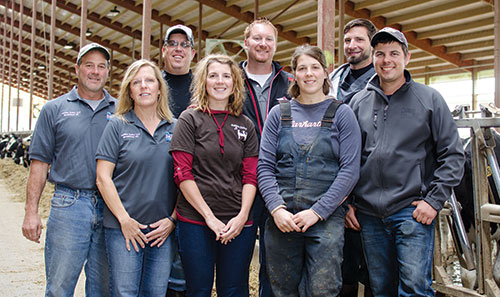
"We use presynch-ovsynch with cows resynched on Day 14," explained Kevin Collins, who is pictured at the far left. "At 35 to 40 DIM, cows are given Lutalyse on a Monday. Two weeks later, we administer a second Lutalyse followed by GnRH two weeks after that. One week later, Lutalyse is given with a dose of GnRH follow-up that Wednesday in the afternoon. Cows are bred 16 to 18 hours later," he went on to say in discussing his Greenleaf, Wis., farm. "To minimize expenses on therapies and semen, our veterinarian ultrasounds all cows at the third Lutalyse."
Reproductive protocols help many dairy farmers get cows safe in calf. This year's Platinum winners of the Dairy Cattle Reproduction Council's awards competition share how they handle schedules and who breeds their cows. These herds were honored at the DCRC annual meeting in Buffalo, N.Y.
Do you utilize synchronization programs?
Ayers Farms, Perryville, Ohio: All first-service cows are bred by timed A.I. We use PG-3-G on cows with prostanglandin (PGF) given on Day 0, GnRH Day 3, GnRH Day 10, PGF Day 17, GnRH Day 19, and cows are bred on Day 20.
On first-lactation heifers we use PG-4-G with PGF given on Day 0, GnRH Day 4, GnRH Day 10, PGF Day 17, GnRH Day 19, and breed on Day 20.
Burns Dairy, Hornell, N.Y.: We use a presynch 14-ovsynch, with all cows receiving 5 to 6 cc Lutalyse (prostaglandin) 14 days after calving, setup Lutalyse on Day 45 to 51, GnRH on Day 59 to 65, Lutalyse on Day 66 to 72 days, and GnRH 56 hours later at Day 68 to 74. We breed 12 to 14 hours after GnRH.
Collins Dairy, Greenleaf, Wis.: We use presynch-ovsynch with cows resynched on Day 14. At 35 to 40 DIM, cows are given Lutalyse on a Monday. Two weeks later, we administer a second Lutalyse followed by GnRH two weeks after that. One week later Lutalyse is given with a dose of GnRH follow-up that Wednesday in the afternoon. Cows are bred 16 to 18 hours later. To minimize expenses on therapies and semen, our veterinarian ultrasounds all cows at the third Lutalyse.
Holmes Dairy, Argyle, Wis.: Cows are started on presynch-ovsynch every week. Cows are given Lutalyse at 54 DIM but are not bred if they show heat. At 68 DIM, we give a second Lutalyse dose and cows are bred if heat is detected. If not bred on the second Lutalyse, we start the ovsynch program 12 days later. That includes GnRH followed by Lutalyse seven days later with GnRH eight hours later with breeding 16 to 20 hours after that.
Kloppe Dairy Farm, New Haven, Mo.: We utilize prostaglandin for cows with metritis and pyometra. Also, any cows late in the voluntary waiting period, those diagnosed with cysts or those that do not show any heats after 55 days are given GnRH seven days prior to prostaglandin.
Schilling Dairy, Darlington, Wis: Every animal is given Lutalyse (prostaglandin) at 21 to 24 DIM to help clean up metritis or endometritis. We do that on Tuesdays and Saturdays. There is no formal presynchronization program.
Lactating cows are all bred on an ovsynch 48-hour program for first service. All cows are started on ovsynch at 70 DIM. One 4 cc dose of Cystorelin (GnRH) is given Tuesday morning; 5 cc of Lutalyse is given seven days later on Tuesday morning; a second Lutalyse (5 cc) is given 24 hours later on Wednesday morning; and GnRH2 (2 cc) is given 48 hours after the second Lutalyse dose on Thursday morning. Breeding is done Thursday, eight hours after the morning GnRH.
Open cows are resynched with a similar program at herd health. If a corpus luteum (CL) is present, ovsynch is started. If a CL is not present, 4 cc of GnRH is given and ovsynch is started seven days later.
Who does your A.I. breeding?
Ayers Farms, Perryville, Ohio: John Kline breeds half the herd at 6 a.m. and Jesse Ayers breeds the other half at 7:15 a.m. We breed about 22 to 25 cows per week on average. We have three different groups that we breed in each week. Being able to breed four to five cows at a time is much more efficient for us than one or two daily. In that way, we are able to spend that time each day working with fresh cows.
Burns Dairy, Hornell, N.Y.: An independent A.I. technician and trained farm personnel breed the cows. There is more than one person on farm trained to breed cows, therefore time off is of no concern. Cows showing heat are bred following the a.m./p.m. breeding rule (if seen in heat in the a.m., breed in the p.m. and vice versa). However, depending on the circumstance, they may be bred immediately after observation of heat.
Collins Dairy, Greenleaf, Wis.: Select Sires chalks and breeds animals. Carl Klug breeds timed A.I. We use Select Sires and Alta Genetics bulls.
Holmes Dairy, Argyle, Wis.: Genex A.I. technician Tim Heiring provides the farm with once-a-day service. Genex relief personnel provide service when Tim is off.
Kloppe Dairy Farm, New Haven, Mo.: Jill Gerling, herd manager, and Megan Barrett, her assistant, do breeding procedures. We prefer to breed within 10 hours of heat detection.
Schilling Dairy, Darlington, Wis: Cows and heifers are bred once every day by Genex technician Tim Heiring. Trisha Pernot and others provide relief for Tim and assist with service on ovsynch breeding days and with keeping the cows painted.
Additional insight from these herds can be found in the November issue of Hoard's Dairyman on pages 731 to 733.
Also, you can click here to read last week's Intel "Nutrition health propels reproduction."
(c) Hoard's Dairyman Intel 2015
November 16, 2015








